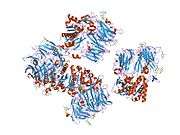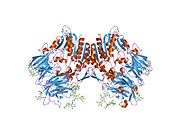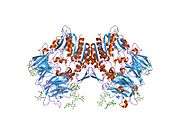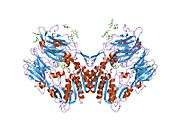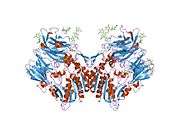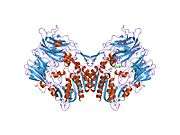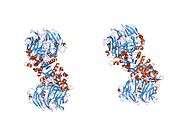Dipeptidyl peptidase-4
| View/Edit Human | View/Edit Mouse |
Dipeptidyl peptidase-4 (DPP4), also known as adenosine deaminase complexing protein 2 or CD26 (cluster of differentiation 26) is a protein that, in humans, is encoded by the DPP4 gene.[5] DPP4 is related to attractin, FAP, DPP8 and DPP9.
Function
The protein encoded by the DPP4 gene is an antigenic enzyme expressed on the surface of most cell types and is associated with immune regulation, signal transduction and apoptosis. It is an intrinsic membrane glycoprotein and a serine exopeptidase that cleaves X-proline dipeptides from the N-terminus of polypeptides.
It is a rather indiscriminate enzyme for which a diverse range of substrates are known.[6] The substrates of CD26/DPPIV are proline(or alanine)-containing peptides and include growth factors, chemokines, neuropeptides, and vasoactive peptides. DPP4 plays a major role in glucose metabolism. It is responsible for the degradation of incretins such as GLP-1.[7] Furthermore, it appears to work as a suppressor in the development of cancer and tumours.[8][9][10]
DPP-4 also binds the enzyme adenosine deaminase specifically and with high affinity. The significance of this interaction has yet to be established.
Animal studies
Animal studies suggest its pathogenetic role in development of fibrosis of various organs, such as liver and kidney.[11][12]
Clinical significance
CD26/DPPIV plays an important role in tumor biology, and is useful as a marker for various cancers, with its levels either on the cell surface or in the serum increased in some neoplasms and decreased in others.[13]
A new class of oral hypoglycemics called dipeptidyl peptidase-4 inhibitors work by inhibiting the action of this enzyme, thereby prolonging incretin effect in vivo.[14]
A new coronavirus related to SARS, named Middle East respiratory syndrome coronavirus, has been found to bind to DPP4. DPP4 is found on the surface of cells in the airways (such as the lungs) and kidneys. Scientists may be able to use this to their advantage by blocking the virus's entry into the cell.[15]
See also
References
- ↑ "Diseases that are genetically associated with DPP4 view/edit references on wikidata".
- ↑ "Drugs that physically interact with Dipeptidyl peptidase 4 view/edit references on wikidata".
- ↑ "Human PubMed Reference:".
- ↑ "Mouse PubMed Reference:".
- ↑ Kameoka J, Tanaka T, Nojima Y, Schlossman SF, Morimoto C (Jul 1993). "Direct association of adenosine deaminase with a T cell activation antigen, CD26". Science. 261 (5120): 466–9. doi:10.1126/science.8101391. PMID 8101391.
- ↑ Chen X (2006). "Biochemical properties of recombinant prolyl dipeptidases DPP-IV and DPP8". Advances in Experimental Medicine and Biology. Advances in Experimental Medicine and Biology. 575: 27–32. doi:10.1007/0-387-32824-6_3. ISBN 978-0-387-29058-4. PMID 16700505.
- ↑ Barnett A (Nov 2006). "DPP-4 inhibitors and their potential role in the management of type 2 diabetes". International Journal of Clinical Practice. 60 (11): 1454–70. doi:10.1111/j.1742-1241.2006.01178.x. PMID 17073841.
- ↑ Pro B, Dang NH (Oct 2004). "CD26/dipeptidyl peptidase IV and its role in cancer". Histology and Histopathology. 19 (4): 1345–51. PMID 15375776.
- ↑ Masur K, Schwartz F, Entschladen F, Niggemann B, Zaenker KS (Dec 2006). "DPPIV inhibitors extend GLP-2 mediated tumour promoting effects on intestinal cancer cells". Regulatory Peptides. 137 (3): 147–55. doi:10.1016/j.regpep.2006.07.003. PMID 16908079.
- ↑ Wesley UV, McGroarty M, Homoyouni A (Feb 2005). "Dipeptidyl peptidase inhibits malignant phenotype of prostate cancer cells by blocking basic fibroblast growth factor signaling pathway". Cancer Research. 65 (4): 1325–34. doi:10.1158/0008-5472.CAN-04-1852. PMID 15735018.
- ↑ Kaji K, Yoshiji H, Ikenaka Y, Noguchi R, Aihara Y, Douhara A, Moriya K, Kawaratani H, Shirai Y, Yoshii J, Yanase K, Kitade M, Namisaki T, Fukui H (Mar 2014). "Dipeptidyl peptidase-4 inhibitor attenuates hepatic fibrosis via suppression of activated hepatic stellate cell in rats". Journal of Gastroenterology. 49 (3): 481–91. doi:10.1007/s00535-013-0783-4. PMID 23475323.
- ↑ Min HS, Kim JE, Lee MH, Song HK, Kang YS, Lee MJ, Lee JE, Kim HW, Cha JJ, Chung YY, Hyun YY, Han JY, Cha DR (Jun 2014). "Dipeptidyl peptidase IV inhibitor protects against renal interstitial fibrosis in a mouse model of ureteral obstruction". Laboratory Investigation. 94 (6): 598–607. doi:10.1038/labinvest.2014.50. PMID 24687121.
- ↑ Havre PA, Abe M, Urasaki Y, Ohnuma K, Morimoto C, Dang NH (2008). "The role of CD26/dipeptidyl peptidase IV in cancer". Frontiers in Bioscience. 13 (13): 1634–45. doi:10.2741/2787. PMID 17981655.
- ↑ Rosenstock J, Zinman B (Apr 2007). "Dipeptidyl peptidase-4 inhibitors and the management of type 2 diabetes mellitus". Current Opinion in Endocrinology, Diabetes, and Obesity. 14 (2): 98–107. doi:10.1097/MED.0b013e3280a02f65. PMID 17940427.
- ↑ Raj VS, Mou H, Smits SL, Dekkers DH, Müller MA, Dijkman R, Muth D, Demmers JA, Zaki A, Fouchier RA, Thiel V, Drosten C, Rottier PJ, Osterhaus AD, Bosch BJ, Haagmans BL (Mar 2013). "Dipeptidyl peptidase 4 is a functional receptor for the emerging human coronavirus-EMC". Nature. ScienceNews. 495 (7440): 251–4. doi:10.1038/nature12005. PMID 23486063. Lay summary – ScienceNews.
Further reading
- Ansorge S, Bühling F, Kähne T, Lendeckel U, Reinhold D, Täger M, Wrenger S (1997). "CD26/dipeptidyl peptidase IV in lymphocyte growth regulation". Advances in Experimental Medicine and Biology. 421: 127–40. doi:10.1007/978-1-4757-9613-1_17. PMID 9330689.
- Reinhold D, Kähne T, Steinbrecher A, Wrenger S, Neubert K, Ansorge S, Brocke S (2003). "The role of dipeptidyl peptidase IV (DP IV) enzymatic activity in T cell activation and autoimmunity". Biological Chemistry. 383 (7-8): 1133–8. doi:10.1515/BC.2002.123. PMID 12437097.
- Sato K, Dang NH (Mar 2003). "CD26: a novel treatment target for T-cell lymphoid malignancies? (Review)". International Journal of Oncology. 22 (3): 481–97. PMID 12579300.
- de Meester I, Lambeir AM, Proost P, Scharpé S (2003). "Dipeptidyl peptidase IV substrates. An update on in vitro peptide hydrolysis by human DPPIV". Advances in Experimental Medicine and Biology. Advances in Experimental Medicine and Biology. 524: 3–17. doi:10.1007/0-306-47920-6_1. ISBN 0-306-47717-3. PMID 12675218.
- Koch S, Anthonsen D, Skovbjerg H, Sjöström H (2003). "On the role of dipeptidyl peptidase IV in the digestion of an immunodominant epitope in celiac disease". Advances in Experimental Medicine and Biology. Advances in Experimental Medicine and Biology. 524: 181–7. doi:10.1007/0-306-47920-6_22. ISBN 0-306-47717-3. PMID 12675238.
- Pro B, Dang NH (Oct 2004). "CD26/dipeptidyl peptidase IV and its role in cancer". Histology and Histopathology. 19 (4): 1345–51. PMID 15375776.
External links
- The MEROPS online database for peptidases and their inhibitors: S09.003
- Dipeptidyl-Peptidase IV at the US National Library of Medicine Medical Subject Headings (MeSH)
- Banting and Best Diabetes Centre at UT dpp4










